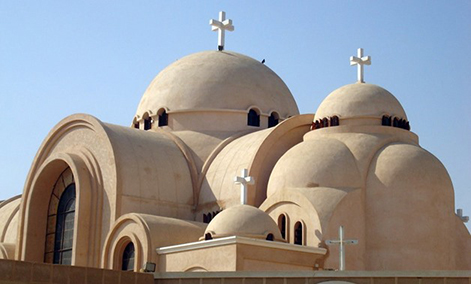“Who founded Skellig monastery?” remains a moot question, as the lawyers say. The relevant contributors to this book have to admit that though the name of St Fíonán is associated with the early centuries of Skellig’s human history, who truly founded the monastery is an obscure issue. But it may be that light on this problem might be cast from what too many in Ireland may think an unexpected source, the Western Desert of Egypt.
A distinguished light of the Irish Bar, the late Dermot Kinlen (whom I knew well when we were both members of the committee running a society concerned with oriental culture based on the Chester Beatty Library, then still in its original home.)
Late in 1991 he made a visit to Egypt, during the course of which he travelled out into the Western Desert to see the Wadi el-Natroun. Once an isolated place this can now be reached by a new highway running from Cairo to Alexandria. In the Wadi el-Natroun he visited one of the four famous monasteries. This was the Anba Beshoy Monastery, named for a monk who went into the desert about 300AD. Many followed him. In 1991 there were still 150 monks there.
Dermot Kinlen was assisted by Bro. James who acted as his guide. Dermot Kinlen told Bro. James about the annual visits he had been making to Skellig Michael since 1943. Bro. James was most interested. He knew of that place, “and that a monk from his monastery had founded the monastery on Skellig Rock”.
This was quite a claim. Kinlen knew that monasteries had begun in Egypt with St Anthony the Great, who died in 356AD. They talked about the Coptic influences on Celtic art, and on the stylistic comparisons which had been made between the Syrian Coptic chalices the Irish might have been imitating in creating the Derrynaflan Chalice.
When he heard this claim about the Copts founding Skellig, the then Irish Ambassador to Egypt, Eamonn Ó Tuathaill, was careful. He asked for some primary sources for this claim, but the monk was only able to pass on a set of secondary sources, as the actual monastic librarian was at that time away in Cairo.
I have read nothing since setting out in more historical detail what the Coptic claim by Anba Beshoy monastery was. So it seems there is perhaps more to be discovered there too about the Skelligs.


 Peter Costello
Peter Costello The domes of the Anba Beshoy provide a contrast to those of the Skelligs.
The domes of the Anba Beshoy provide a contrast to those of the Skelligs. 